Lots of things are set to 4 year cycles: presidential elections, undergraduate degrees, actors playing Spiderman (sorry Andrew Garfield). Four years ago, we started asking engineering marketers about their annual marketing budgets. Just last week we released our findings for 2017 in an eBook that you can  .
.
Running this survey for four years has highlighted a dramatic shift in the major challenges these marketers face.
A few years ago marketers consistently said that their biggest challenge was “Not enough budget.” Today its “Not enough leads.” Why has that changed?
Budgets OK, Leads AHHHHHHHH!!!!!!!
In the chart below I’ve isolated the two biggest changes in reported challenges over the last 4 years. Need for Leads was a concern for 34% of marketers in 2014, today it’s a challenge for 55% of marketers. That has corresponded with a downwards shift in concern about budget from 44% of marketers in 2014 to 31% in 2017.
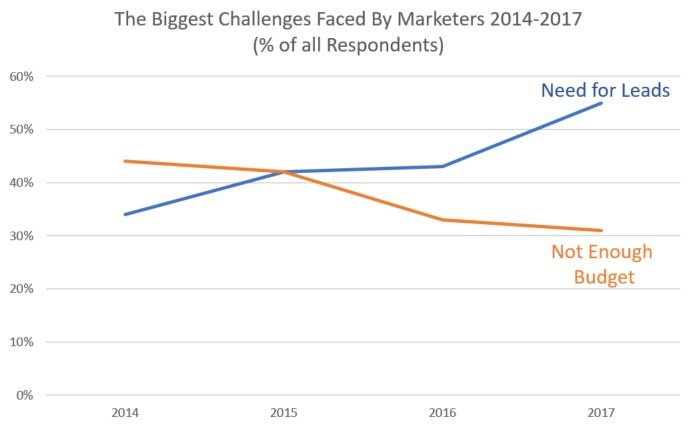
Now, lets layer on another common marketing challenge to the above graph – content creation.
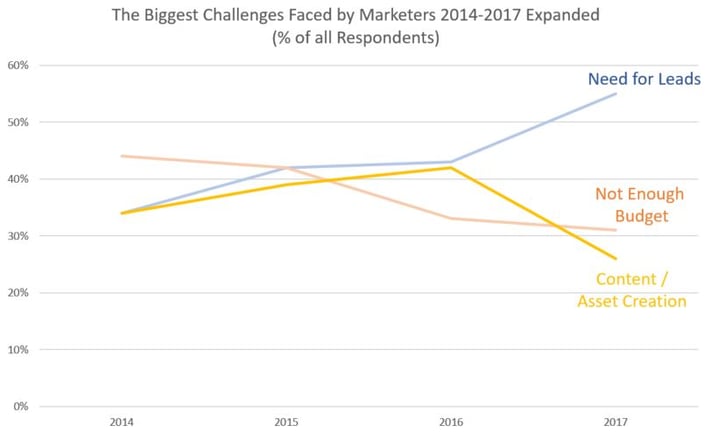
From 2014 to 2016 Content / Asset Creation and Need for Leads followed very similar upward trends. However, in 2017 the two diverged completely. The number of marketers concerned with Content / Asset Creation plummeted and at the same time that the Need for Leads rocketed upwards.
Something seems wrong here doesn’t it? The way you generate leads in the digital age is by having relevant content that attracts and then progresses customers along their buying journey. How is it possible that content creation is somehow easier but generating leads has become more difficult? Further, is it possible that some other force independent of the relationship between content and need for leads is driving the trend we’re seeing in 2017?
It’s Not Just About Being Good. It’s About Being Seen
Based on the two “hockey stick like” trends we’re seeing in the above graph (one upward, one downward), it seems that a stick switch was flipped in 2016. Marketers had the resources (and likely managerial support) to invest in content in 2016, but generated fewer leads than they expected, which made lead generation such an important focus this year. One explanation for marketers generating fewer leads than expected is a problem with distribution.
You and your competitors are now either fully onboard with content marketing (In the 2017 study we found that 87% of engineering marketers now use content marketing) or well on your way. Search engine results pages are now filled with content, making it much less likely for your content to be found organically. This would mean even with the best content out there you’re going to struggle to ensure that it ends up in the hands of your target customer. This is a problem that growth-focused digital luminaries like Peter Thiel and Mark Schaefer have identified and written extensively about.
No matter how strong your product—even if it easily fits into already established habits and anybody who tries it likes it immediately—you must still support it with a strong distribution plan – Peter Thiel
Some of your peers have already figured this out and made adjustments going into 2017. One thing we like to do in our Annual Campaign Plans Report is look at how Top Performing Marketers, those outpacing the growth of the market, are investing their marketing dollars. In the graphs below you can see what percentage of Top Performers over the last few years dedicated more than 10% of their budget to various content distribution tactics/channels.
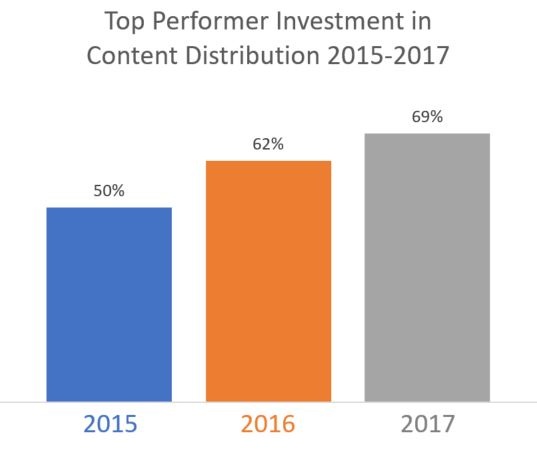
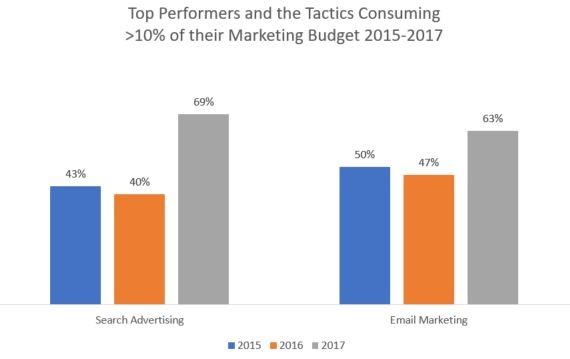
As you can see over the last few years, Top Performing Marketers have really ramped up their focus on distributing content. They’ve also in the last year spiked their investment in search and email, both tactics that complement paid content distribution.
C.R.E.A.M.
Cash rules everything around me…and you, and your competition. Marketers, like anyone else with goals, are going to adjust their behavior based on what they’re evaluated on. The chart below shows how marketers are evaluated (their goals) in 2017 compared to 2016.
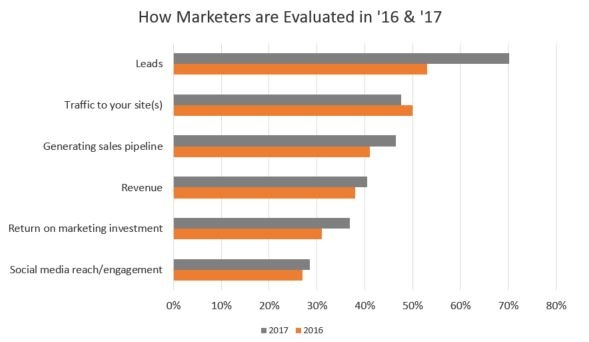
The big change between the two years was that many more marketers are now being tasked with generating leads. This of course will impact their perception of the challenges they face and partially explains what we saw in the previous section. It also signals something more important though – a maturation of the digital marketing space. In 2014, digital marketing to engineers was still a fledgling industry. It was a shiny place filled with exciting new channels to explore. Just take a look at 2014’s numbers for budget expansion:

That’s right, in 2014 we thought that social was the place in most need of further investment. While we’ve all realized to varying extents that social has its value as part of our marketing mix, I doubt anyone in 2017 thinks its their organization’s top investment priority. In 2017 we’ve grown as marketers, moving pass the sexy digital channels and vanity metrics to focus on what marketing has always been about – generating enough leads for sales.
Started From the Bottom Now We’re Stuck
Clearly Drake was not a marketer, otherwise he’d know you start from the Top of Funnel and move to the Bottom. That being said, lead obsessed marketers are pulling a Drake and forgetting this fact.
Were I to run our 2017 survey again I would have asked marketers to identify their mix between top of funnel, middle of funnel, and bottom of funnel content. Since I can’t do that, I instead reviewed content campaigns that we ran over the last two years for our advertising customers. Over 60% of the content resources were bottom of funnel assets, 30% were from the top, and only 10% were from the middle.
The resources we host and the paid distribution campaigns we run to promote them directly reflect the desires of our customers. What the above data indicates is that marketers are focused on surfacing sales-ready leads without first putting content in place to attract future customers earlier in their buying journey. Marketers are being asked to provide pipeline, and the easiest way to ensure the tap is flowing is to put all their effort into getting people already at the bottom or near to it. While this may help with meeting quarterly lead goals, in the long run it is inefficient, as the opportunity for contacts to investigate and build purchase intent is lost.
It’s tempting to focus too tightly on your immediate goals, but content marketing isn’t a sprint, it’s a marathon. Robert Rose has framed this as a battle between “value in time” and “value over time.” Campaigns to generate leads are value in time, you invest X and reap a number of leads Y. Executives are happy with this because it’s easily measured and works towards immediate goals. In contrast, content is value over time. The dividends may not be seen today or tomorrow but the value of it accrues with time. Marketers thus feel squeezed (or challenged) in how they are evaluated, because while content is becoming easier to manage, their evaluation criteria is misaligned. Managers are demanding leads today on today’s investment ignoring that content is a long-term game and trying to conform new tactics to old measurement systems and performance windows.
My advice to you is as best you can, split your investment between the tactics that will help you find the leads you need today, while also ensuring the leads you want next quarter and the quarter after that will be there. I assure you, there isn’t a quarter on the horizon where you won’t need leads, so make your life easier and create and distribute content for all stages of the buyer journey today.
Until next time,
Andrew





